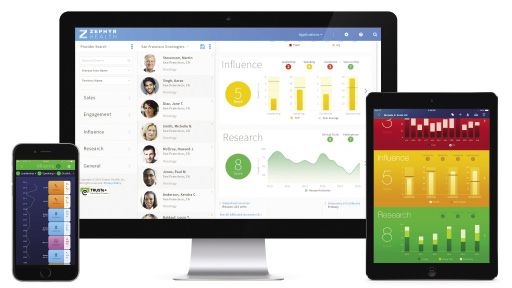Powering up medical affairs
Technology is enabling more resources to reach the medical affairs teams—in a compliant manner
Zephyr Health’s IT system provides desktop and mobile data access. Credit: Zephyr

In a world where health systems are increasingly focused on value-based pricing and personalized treatments, the heightened emphasis on scientific exchange between the pharmaceutical, biotech, medical device and diagnostic industry and its customers has never been greater. The perception that the sales representative is the sole interface between industry and healthcare providers (HCPs) is actually changing, with growing importance being placed on the role and functions of medical affairs. As a result, medical affairs teams, responsible for interacting with physicians and payers about scientific publications, off-label usage, product safety and independent medical education, have seen staggering growth in recent years. [1] At the heart of this shift sit the medical science liaisons (MSLs)—highly qualified personnel, often PhDs or MDs, who help communicate product-related science to prescribers, key opinion leaders (KOLs) and payers.
While this shift has been welcomed by health systems, who thirst for the scientific knowledge necessary to remain patient-centric, the challenge is to remain vigilant of promotional compliance regulations. Medical affairs teams must maintain a respectful distance from traditional sales and marketing functions, a point noted in early guidance emerging in 2003 from the HHS Office of Inspector General (OIG), which clearly stated that grant funding from pharmaceutical manufacturers must remain independent from physician referrals for medical products. [2]
At the same time, increasing pressure has been placed on the life sciences industry in relation to promotional compliance, including transparency around traditional sales and marketing activities with HCPs through measures such as the US Physician Payments Sunshine Act (2010). This regulation, which is reflected in similar legislation in other markets, requires life sciences companies to log, track and report on HCP spending. As a result, physicians are reacting by exercising increased caution when participating in engagements with industry, in particular when there is any kind of compensation. For example, in December 2013 GlaxoSmithKline announced that it would stop compensating HCPs for speaking on the company’s behalf regarding its products and related disease areas, and would in fact rely on its own internal experts to communicate with disease-area experts, potential prescribers and other HCPs. [3]
‘Illuminating’ key data
First announced about a year ago, Zephyr Illuminate is of a category of IT solutions that the company, and some others [1], call “insights as a service;” whether this moniker will hold remains to be seen. At its heart, Zephyr Illuminate is a combination of patented, machine learning algorithms that create predictive insights using global health data for major treatment areas from thousands of connected data sources—public, private and vendor-sourced. These Big Data techniques—operating on a cloud-based platform—produce meaningful results (“insights”) for such questions as, which healthcare providers (HCPs) or healthcare organizations should a company target for a medical education campaign? How can a target customer or market be segmented to improve commercial performance through increased customer engagement? What communication channels are most effective with which customers? Which HCPs or KOLs are industry up-and-comers? All in the spirit of improved data-driven targeting and deep customer profiles.
According to Zephyr, the system can be set up in a transparently compliant manner so that medical affairs personnel and sales personnel have a shared view of customers, yet have defined viewership of information based upon their roles, e.g., claims or sales performance data is not available to a medical affairs user. Patient data, when part of the database, are de-identified and HIPAA-compliant.
1) See Vendor Landscape: Insights Service Providers, May 2016, Forrester Research
The cost of incorrect reporting is significant; whether the misdemeanor is intentional or not, there are financial and reputational risks. For example, unintentional failure to report a transfer of value to an HCP can cost a manufacturer a fine of $10,000 for each individual transfer of value, up to a maximum of $150,000 annually. If a manufacturer is thought to have knowingly held that information back, then the possible fine increases—up to $100,000 per infraction up to a maximum of $1 million. These sums might seem small to a multinational, but in addition to the cash sums, punishment for knowingly failing to submit reporting data can result in the OIG imposing a corporate integrity agreement on the manufacturer.
Market pressures and heightened focus on transparency and compliance, combined with the exponential growth of publicly accessible data sources, have created unique challenges for medical affairs teams, given its responsibilities in scientific data generation and dissemination.
As with many changing market dynamics however, these also represent an opportunity within life sciences companies for better planning and execution of their strategic programs, while ensuring compliance. Now more than ever, Medical Affairs teams can lead their scientific initiatives with fact-based insights by integrating their internal tracking systems with the growing set of external data sources available to them to ensure a clear audit trail of activity and to meet regulatory demands. Whether in the selection process that identifies KOLs, prescribers and payers, or their recorded interactions, new technology solutions provide an increasingly transparent, objective and compliant way to better manage data across an entire organization.
In view of this, there are three exciting opportunities for medical affairs teams to address these challenges and transform their initiatives with fact-based insights:
- Identification and management of thought leaders
- Alignment of home office and field based initiatives
- Measurement of medical affairs activities
Despite advances in access to data, it is still difficult for life sciences companies to identify and engage with thought leaders using objective, up-to-date and integrated data sets. This is due to the difficulties in aggregating disparate data sources—internal or purchased. In particular, 80% of publicly available global health data is unstructured, [4] which presents unique challenges for integration.
For Medical Affairs this means that researching and identifying new thought leaders is more often based on anecdotal feedback from the MSLs, or time-consuming online searches, and less on objective and quantifiable data. Furthermore, understanding more about the connections between these thought leaders and the institutions where they work, as well as the other healthcare providers they work with, is arduous to ascertain. Detecting changes or updates to healthcare provider or organization profiles is even more challenging over time. For instance, getting updates on recently published articles or participation in new clinical trials, or even understanding an HCP’s engagement with a competitor can be taxing and time consuming.
In fact, according to two recent Zephyr Health engagements with top 10 biopharma companies, it was estimated that MSLs spent between 20 and 30% of their time researching and profiling thought leaders. The results of ad hoc searches to locate such information are frequently tracked in Excel sheets or in individuals’ files, making consistency and compliance questionable. This makes it challenging for therapeutic area heads to validate proposed thought leader candidates lists, develop key account engagement plans and perform MSL territory planning with confidence, especially if he/she does not know the candidates.
Next-generation technology solutions are helping to reshape Medical Affairs thought-leader programs by providing a systematic and objective way of identifying thought leaders and institutions. The integration of public global health data, third-party licensed and internal data into a single holistic view means medical affairs teams have up-to-date customer profiles and can extract relevant and immediate insights on key thought leaders, accounts and institutions. Thought leader engagement and medical education programs can be transformed by having the right information to share with the right customer, at the right time in a compliant manner—meeting the need to disseminate critical science to key stakeholders, while enhancing credibility and corporate reputation.
Identifying and populating the information gaps from MSLs’ anecdotal knowledge of key customers is one challenge—effectively recording their activities and sharing field insights with home office is another. While sophisticated customer relationship management (CRM) systems are now routine for field-based personnel, information found within emails, voicemails and personal notebooks may not always be recorded. Even when it is, it can get lost in translation to medical affairs managers, therapeutic area heads and medical directors, which limits market insights and poses significant compliance risks. A further example is the management of payments to KOLs for speaking engagements, a company might already have the physician’s details, records of travel expenses and speaking services provided, but the payment details themselves—the date the payment is made for instance—are very likely only available on a separate accounts payable system.
Many companies have established firewalls between medical affairs and commercial functions, in addition to implementing corporate integrity agreements, to ensure regulatory compliance, but two key challenges remain. First, the lack of direct communication between medical affairs and sales means there are often inconsistent views of the same customer, which creates inefficient engagement processes and frustration for HCPs. Second, and more important from a compliance aspect, failure to separate medical affairs and commercial activities can pose a significant risk in the face of external audit. For example, Allergan was required to make a $600m settlement in 2010 after failing to separate promotional and educational activities in relation to its blockbuster drug Botox. [5]
Innovative technology solutions are helping life sciences companies align external and internal information into a single, synchronized view of HCPs and their related institutions or organizations. Sales and medical affairs activities can be closely monitored and insights shared across all divisions of the company in a compliant manner thanks to user and role-based access, which allows for a clear separation between medical interactions and sales engagements. For example, sales teams can only see HCP and institution profiles in their assigned territory and cannot view any medical interactions data.
Similarly, medical affairs teams can view research and medical interactions data but are restricted from seeing prescription volume or sales interactions information. Marketing teams can see all commercial interactions data to drive brand strategy but have limited access to medical interactions data. These roles and defined viewership can be tailored for each company, meeting specific company-based compliance requirements.
By better connecting home office and field-based personnel with both web-based and mobile solutions, medical affairs can optimize strategic planning and gain real competitive advantage. MSLs have visibility of, and learn from, collective experiences with customers, while headquarters can react more nimbly to changes in the external market, all while ensuring regulatory compliance.
With an accurate view of thought leaders, KOLs, HCPs and institutions and alignment between home office and field-based activities in place, the final challenge for medical affairs is in measuring the performance of its activities, both for communicating benefit to senior management and for providing appropriate incentives for personnel.
Proving the value of, and providing the right performance incentives around medical affairs initiatives and actions is a constant battle as measuring the success of programs cannot be directly linked to sales and revenue, for exactly the reasons stated above. Innovative metrics must be developed to meet this challenge and, most importantly, stand the compliance test. Key performance indicators often include the number of calls a medical information center receives or number of KOL relationships per MSL. These can provide insight into the level of productivity, but relay little about how impactful specific programs are.
Here again, technology is a key differentiator, aggregating statistics and data to efficiently track the progress of initiatives over time. By deploying next-generation data aggregation and insights solutions, medical affairs teams can measure the relative performance of HCPs across multiple categories such as research, influence, engagement and more. For example, measuring the change in a customer’s sentiment, involvement in trials or authorship of new publications, specifically in relation to company-sponsored products, is now possible and provides a tangible way to monitor the impact of medical affairs’ activities.
With objective measures of performance, medical affairs teams can quickly and easily relay the impact of their initiatives to those therapeutic area heads and senior managers who have a view across medical and commercial activities, allowing them to track the impact of all functions. This allows development of more credible strategic plans and better allocation of resources, while also ensuring appropriate, compliant rewards for those involved in deploying effective medical programs.
Changes in the healthcare environment have led to the growing importance of medical affairs activities, while a concomitant tightening of the regulatory environment for life sciences companies, including measures like the Sunshine Act, means such activities must be more closely monitored and measured. Transparency around engagement with HCPs is clearly here to stay and it is forcing the industry’s hand when it comes to capturing data and delivering insights.
Populating information gaps and integrating data across the business are the key areas that companies must address for successful and compliant implementation of medical affairs activities. Disparate data sources within an organization are a significant challenge, and integrating those systems is no small feat. This point is highlighted no better than in research conducted by SAP, which concluded that a life sciences company could have HCP spend transactions originating from as many as 20 different sources and systems. [6] Mistakes made because of fragmented data can have costs that far outweigh the transfer of value in dispute.
With next-generation technology, life sciences companies can now benefit from a single-point solution that aggregates data and tracks spend—and that provides the analytical insight to build up HCP and institution profiles, monitor the success of interactions with them, and ensure compliance by separating medical affairs and commercial activities. With such systems, the industry can transform thought leader and medical education programs using consistent, fact-based solutions, while also meeting compliance requirements. The more relevant and appropriately aligned interactions the industry has with HCPs and thought leaders, the more they build trust and better relationships with consumers and the medical community at large.
Medical affairs will play a vital role in the future success of the life sciences industry. Those companies investing in the right solutions to empower their medical affairs teams with insights will develop better customer relationships and gain significant competitive advantage—their future will be insightfully compliant.
References
- Focus on Life Science Compliance: The Evolution of Medical Affairs Departments (2011), McGuireWoods LLP, accessible at https://www.mcguirewoods.com/news-resources/publications/health_care/focus-life- science-compliance-nov-2011.pdf
- Pharmaceutical Compliance Guidance Program for Pharmaceutical Manufacturers, Apr. 2003 (68 Fed. Reg. 23735 [May 5, 2003]), accessible at http://oig.hhs.gov/authorities/docs/03/050503FRCPGPharmac.pdf
- GSK Announcement May Change Industry Speaker Programs (2014), Law360, accessible at http://www.law360.com/articles/505701/gsk-announcement-may-change-industry-speaker-programs
- Five Things You Never Suspected About Your Healthcare Data (2015), Forbes, accessible at http://www.forbes.com/sites/robertszczerba/2015/08/19/five-things-you-never-suspected-about-your- healthcare-data/#4626
- Allergan Will Pay Fine, Plead Guilty to Misdemeanor (2010), Bloomberg, accessible at http://www.bloomberg.com/news/articles/2010-09-01/allergan-will-pay-600-million-plead-guilty-to- misdemeanor-in-botox-probe
- SAP White Paper—Engaging the Healthcare Practitioner (2010), SAP, accessible at http://www.sdn.sap.com/irj/scn/go/portal/prtroot/docs/library/uuid/c06c7336-6195-2d10-b18b- 94527b9196a9?QuickLink=index&overridelayout=true&48747879804892
ABOUT THE AUTHOR

William King is the founder and executive chairman of Zephyr Health; the Insights-as-a-Service leader harnessing the power of global health data to help pharmaceutical, biotech, medical device and diagnostic companies engage the right physicians, accounts and institutions. Prior experience includes global leadership positions in sales, marketing and strategy at Johnson & Johnson. His bachelor’s degree in business administration is from the University of Denver.
Save
Save
Save
Save
Save
